Super Puma Epicyclic Gear Health Monitoring Background
The investigation into loss of CHC Helikopter Service Airbus Helicopters EC225/H225 LN-OJF on 29 April 2016 has created interest in the health monitoring on the type’s epicyclic planet gears.
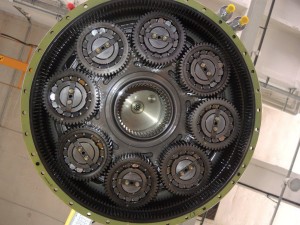
A View from Below of a 2nd Stage Epicyclic Stage. Note the 8 Planet Gears and the Bearings within them (Credit: AAIBN)
This article draws on a the most recent Accident Investigation Board Norway (AIBN – the Statens Havarikommisjon for Transport [SHT] in Norwegian) 102 page preliminary report on the LN-OJF accident, issued on 28 April 2017.
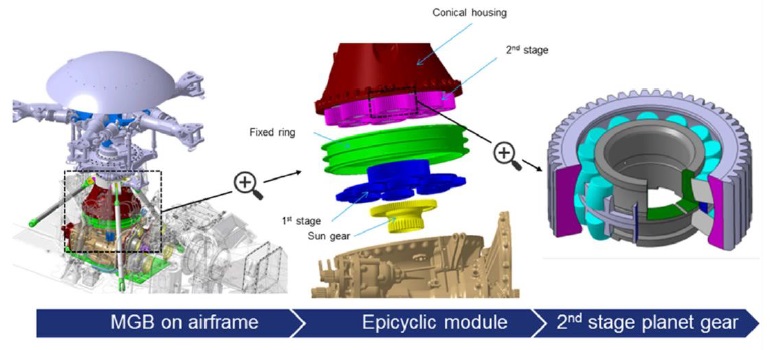
MGB, Exploded View of Epicyclic Module and a Second Stage Planet Gear (Credit: Airbus Helicopters via AIBN).
AIBN say that LN-OJF suffered a second stage planet gear fatigue failure which…
…had its origin in the surface of the upper outer gear race of the planet gear. It started at the surface and propagated sub-surface with a shallow angle into the bulk material, turning towards the web of the gear teeth and the final through-thickness fracture.
This had similarities to the Bond G-REDL AS332L2 Super Puma accident on 1 April 2009 in the UK (the AS332L2 being the previous member of the Super Puma family).
- Aerossurance examined the wider aspects of the accident in our feature: EC225 LN-OJF Norway Accident Investigation Timeline
- We discussed the particular component that failed in our article: Super Puma Second Stage Planet Gear Background
- Readers wishing to understand the wider gearbox architecture are advised to read Aerossurance’s article: EC225 Main Rotor Head and Main Gear Box (MGB) Design
In this article we look at the oil debris health monitoring and vibration health monitoring matters in more detail.
The EC225 Main Gearbox Magnetic Chip Detection (MCD) Health Monitoring
The EC225 is fitted with an MCD system designed to detect and retain chips of ferrous debris from gears, bearings etc. The AIBN state that Airbus Helicopters has confirmed to them that this system is “the primary method of detecting planet gear bearing degradation” and relies on “the gears shedding metallic debris before failure”. This is typically in the form of a mechanism known as spalling. Spalling is one of the most common bearing failure modes.
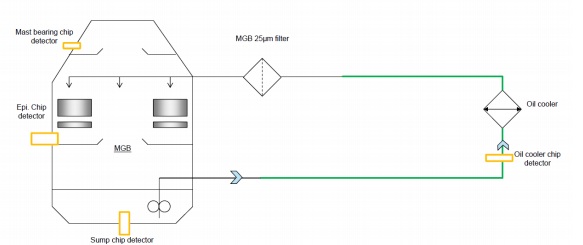
EC225 MGB and Oil System Schematic Showing the Chip Detection System (Credit: Airbus Helicopters via AIBN)
The AIBN explain that:
For the EC 225 LP, the mast bearing chip detector, the epicyclic module chip detector and the sump chip detector are connected to a flight crew warning circuit. Thus, a visual warning to the flight crew is provided when one particle of sufficient size or a sufficient cumulative quantity of particles, bridge the axial gap of the magnetic plug.
Generic Magnetic Chip Detector (MCD) Illustration. MCDs can be manually removed and inspected. (Credit: Adapted by AIBN from UK AAIB G-REDL Report)
The oil cooler chip detector is not connected to any warning system [and so is known magnetic plug / mag plug] and must be inspected visually [periodically].
Changes after the G-REDL Accident
A number of actions were taken after the 2009 G-REDL accident:
- Removal of the epicyclic module magnets. The oil collector plates under the epicyclic module of the EC225 and the AS332L2 had been designed with a ring of magnets to catch particles coming from the epicyclic module and falling into the lower gears. The AIBN say that in the case of G-REDL “It was thought that these magnets prevented particles from entering the chip detectors and thus reduced the efficiency of the chip detection system”. However, they were never checked when gear material was found 36 flying hours before the G-REDL accident as the debris was misidentified (see below).
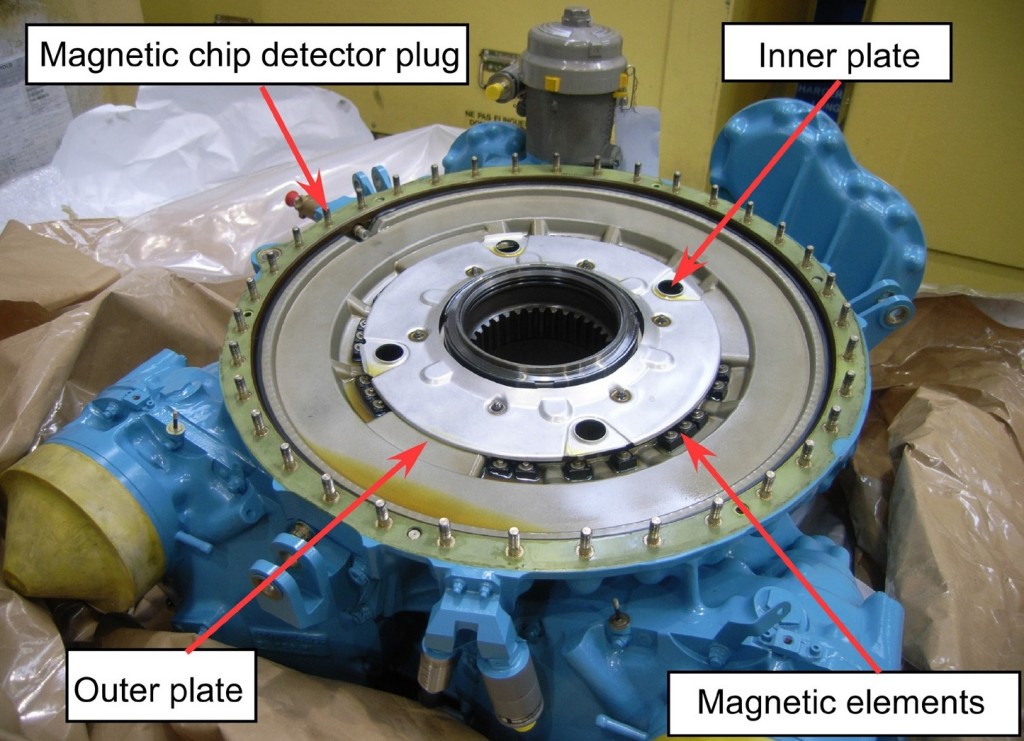
AS332L2 Main MGB Module with Epicyclic Module Removed, Showing the Concentric Collector Plates, the Original
Ring of Magnets and the Epicyclic MCD Location (Credit: AAIB)
- Recommended connection of the epicyclic module chip detector to the crew warning circuit for AS332L2 (thus matching the EC225 design).
- Standardised reduction of chip detectors visual inspection intervals.
- Revised removal criteria for the MGB following collection of particles. At the time of LN-OJF accident, the criteria for MGB removal was accumulation of 50mm² of metal particles or any particles of >0.4 mm thickness, or >2mm length particle or >2mm² surface area (described in Airbus Helicopters Safety Information Notice (SIN) 2075-S-63 issued on 9 July 2009).
The AIBN comment that:
The process of identifying particles also relies on human performance and interpretation, which turned out to be challenging in connection with the G-REDL accident.
SIN 2075-S-63 introduced illustrations of debris to aid identification. No clear explanation was provided by either the AAIB G-REDL report or the the G-REDL Fatal Accident Inquiry, held under a Sheriff in Aberdeen in 2014, for the mis-identification by maintenance personnel of the ferrous gear debris on the magnetic chip detector as non-ferrous ‘scale’ or ‘silver cadmium’ and the cancellation of an early gear box removal.
Airbus Helicopters also launched a MGB spalling test program after G-REDL. Test data…
…has shown that the total detection rate (% of all free magnetic particles expected to be collected on the plugs) is 12 %, while 44 % of the particles were said to end up in the oil filter.
Oil Health Monitoring Performance During Test. 12% of debris was detected by MCDs, 44% caught in the oil filter and 44% was assumed at the time to be left in the MGB. AIBN now suspect some may have been trapped in the oil cooler. (Credit: Airbus Helicopters via AIBN)
However, due to the recent finding of several particles recovered from inside the oil cooler of LN-OJF [discussed below, the illustration above] is no longer representative. 44% of the particles do not reach the MGB oil filter like the figure shows [shown remaining in the MGB], but particles are actually also collected by the oil cooler.
While the AIBN do not comment on it, it is noticeable that an Oil Debris Monitor (ODM) was fitted in the oil system for the test. It detected 38.6% of all debris, far more effective than the MCDs.
While the specific type was not mentioned it does appear to be an ‘inline’ Oil Debris Monitor that measures debris flowing through it. While no other details are given, such inline ODM products are made by companies such as Gastops, whose MetalSCAN 1000 device is used on a number of aircraft and engine types including:
- Sea King S-61/H-3 (MGB and CT58 engine) with the Canadian military
- Lockheed Martin F-35B Lightning (LiftFan)
- Eurofighter Typhoon (EJ200)
- Pilatus PC-12 (PT6)
- Airbus A320neo (PW1100G)
- Mitsubishi MRJ (PW1200G)
- Irkut MS-21 (PW1400G)
- Bombardier C-Series (PW1500G)
- Embraer E-175 E2 (PW1700G)
- Embraer E-190/E-195 E2 (PW1900G)
The PW1x00G series are geared fan engines with a five planet single stage epicyclic gear driving the fan.
Another option would be Eaton‘s Quantitative Debris Monitor (QDM).
LN-OJF Investigation MCD / Oil Debris Analysis
The AIBN say:
No findings indicate any malfunctions to the chip detection system on LN-OJF, or fail[ure] to follow procedures for inspection and checks before flight. Neither are there any records of magnetic debris findings from inspections made since the gearbox was installed on LN-OJF in January 2016.
No chip warning was given to the flight crew before the MGB failure. The MGB chip detectors were inspected with no findings 15:22 flight hours prior to the accident.
AIBN say the first three spalls from the failed planet gear released up to 28 mm² of metal particles in total prior to the accident. Their individual size and when they were released is not known.
Bridging the axial gap (2.28 mm) of the magnetic plug requires a substantial amount of small particles or one or more large particles.
Evidence indicate that [the much larger] spall 4 was released during the break-up phase.
Investigators were only able to locate one of the three MCDs, the one from the MGB sump, along with the oil cooler magnetic plug. The particles found on the sump MCD and in the sump have been assessed as having been generated during the aircraft break-up sequence.
The AIBN examined the particles sampled from the oil cooler magnetic plug to look for possible fracture surfaces and particle shapes. Due to the small size, particles from the magnetic plug were initially mounted on a carbon sticker for examination. The semi quantitative results based on Energy Dispersive X-Ray Spectrometer (EDS) for classifying these small particles in an accurate manner are difficult due to both contamination and geometry.
During the reexamination several EDS were taken from particles of interest, i.e. those possibly coming from the second stage planetary gear made from 16NCD13. Due to their damage, it was not possible to confirm if these particles were coming from the second stage planet gear spalling.
The oil cooler was initially inspected for internal particles at the AIBN’s premises in Lillestrøm. The oil cooler was filled up with white spirit and plugged. It was then turned over several times and emptied through a filter. Several particles were discovered and these were sent to the Norwegian Defence Laboratories (NDL) for analysis in agreement with Airbus Helicopters.
The metallic particles from inside of the oil cooler appeared larger than those on the magnetic plug. These larger particles were mounted in epoxy and polished for material qualification using EDS. Thus the EDS obtained are more conclusive. Since these particles were fixed in epoxy, examination beside what can be done from the “upper” side was not feasible and thus it was impossible to conclude whether it was spalling.
Significantly:
A majority of the metallic particles obtained inside the oil cooler were aluminium [i.e. not 16NCD13 gear material].
However:
The oil cooler was later sent to Airbus Helicopters for further investigations. During additional cleaning processes, performed in accordance with the procedure described in the latest Emergency Alert Service Bulletins [see below], particles of 16NCD13 were found, notably one particle with a surface area of 1.8mm² (length 1.8mm, width 1.3mm).
During all of the ten additional cleaning processes at Airbus Helicopters more particles were salvaged. The analysis of the particles recovered during these additional cleaning processes has revealed 4.69mm² (5 particles) identified by Airbus Helicopters as 16NCD13 spalls and 18mm² of further 16NCD13 particles which could be spalls but too damaged to be affirmative. These results remain to be discussed in detail between Airbus Helicopters and the AIBN.
Vibration Health Monitoring (VHM) aka Health & Usage Monitoring Systems (HUMS)
Neither the AS332L2 nor the EC225 were certified with a VHM system as essential equipment. However both are offered with a VHM to meet certain customer and operational regulatory requirements (particularly for offshore operations).
On the EC225 the VHM is known as M’ARMS. The As332L2 HUMS is either EuroHUMS or EuroARMS. All three systems are supported by Airbus Helicopters (though EuroARMS is based on GE technology). The AIBN explain that:
The system processes the raw signal from the accelerometers to produce the condition indicators, which are then used to monitor the vibration levels of individual components. The acquisition cycle for one complete set of samples typically lasts about 20 minutes, although some accelerometers are sampled more frequently.
At the end of each flight, as the helicopter is shutdown, the system downloads the HUMS data onto a PCMCIA card. The PCMCIA card can store HUMS data for a maximum of five complete acquisitions. The number of acquisitions will be correspondingly less on flights where insufficient time is available to capture five complete acquisitions, or where insufficient time is spent in certain flight phases particular to certain condition indicators, or if an acquisition is rejected. Data stored at the PCMCIA is also used for Flight Data Monitoring and contains an extract of FDR data.
The HUMS data is transferred from the PCMCIA card to the Ground Station Computer (GSC). On the GSC the condition indicators are calculated and reviewed by engineering personnel to identify, for example, any indicators that may have exceeded their thresholds.
The EC225 M’ARMS has 25 accelerometers, 8 accelerometers on the MGB.
The first and second stages of the epicyclic module [shown in red below] are monitored by one accelerometer, sensor 6 (11RK6). The rotor mast and main rotor bearings [shown in grey] are monitored by one accelerometer, sensor 7 (11RK9).
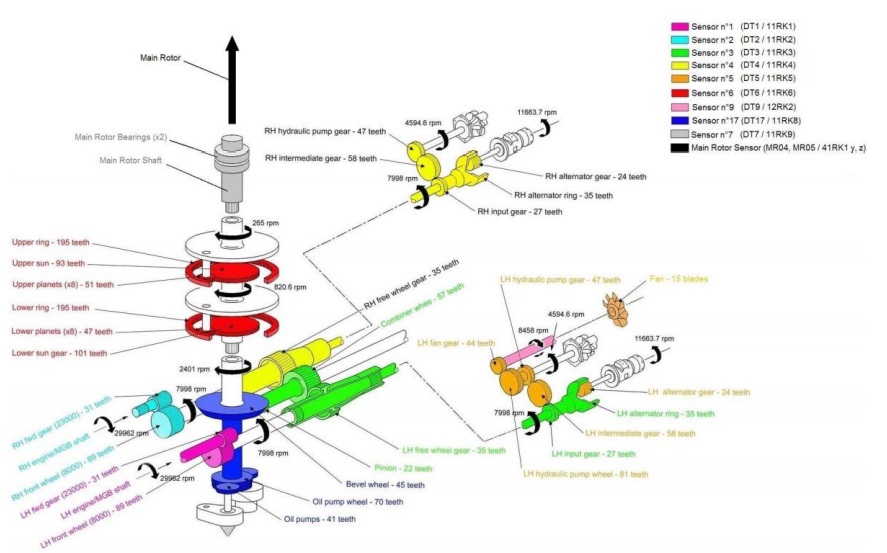
M’ARMS VHM Accelerometer Coverage of the EC225 Rotor Drive System (Credit: Airbus Helicopters via AIBN)
Thresholds are set to allow automatic alerting of maintainers.
- “Amber alerts give an advance warning of a potential problem. This prompts the close monitoring of the indicator and maintenance inspections”.
- “Red alerts indicate that a more serious problem has potentially been found and maintenance action is required before the helicopter is released for flight”.
Alerts are normally only generated when two out of five consecutive indicator values exceed the threshold level, to suppress spurious data spikes.
Two types of thresholds exist:
- Learned thresholds are “a function of the mean and standard deviation of the indicator values recorded to date. They are particular to an individual part on an individual helicopter and based typically on the first 25 flight hours following a part installation or maintenance action on the zone”.
- Fixed or maximum thresholds “are defined by the helicopter manufacturer’s design office”.
The installation of HUMS has been recognized as providing a significant safety improvement to helicopter operations. However, the system has its limitations…
The effectiveness of the vibration analysis for each component depends on the distance of the accelerometer from the component, the transmission path of the vibration and the quality of the electronic signal acquired by HUMS. If any one of these conditions are affected, then the HUMS ability to detect component degradation diminishes.
Epicyclic module planet gear bearing monitoring is particularly challenging, with multiple components rotating on a moving axis. This is also because the energy produced by the meshing of gears tends to be higher than that produced by bearings.
This was observed when the UK Civil Aviation Authority (UK CAA) examined data from the first 6 years of operational HUMS use (1991-1997). Success rates were higher in the smaller tail and intermediate gear boxes and the epicyclic gears were worst.
AIBN explain:
Vibration produced by bearings is of high frequency and low amplitude, which attenuates with distance, meaning that the accelerometer must be located in close proximity to the bearing for effective monitoring. For components such as the tail rotor drive shaft support bearings, the accelerometers are mounted close to the bearings and monitoring has proven to be effective. As epicyclic bearing information is not synchronous with shaft rotation, signal averaging is not used in bearing vibration signal acquisition. This means that components generating signal noise, in the same frequency range as the bearing acquisition, will contribute to the levels of noise in the bearing signal.
LN-OJF VHM Analysis
The PCMCIA card for LN-OJF was recovered from the wreckage, but the VHM data for the last flight was lost as it is only recorded on the card at shut down.
On behalf of the AIBN, Airbus Helicopters examined the M’ARMS data in CHC’s backup database for 4 March to 29 April 2016 (over 150 flying hours of vibration data). They concluded (not surprisingly in-light of the UK CAA’s earlier data) that:
Based on the detailed review of all M’ARMS Condition Indicators computed on A/C LN-OJF S/N 2721, Airbus Helicopters confirms that neither clear trend nor abnormal vibration behaviours have been observed on any dynamic parts monitored by this M’ARMS system.
Therefore, prior to the last flight and accident event, Airbus Helicopters confirms that the M’ARMS system does not show evidence of any vibrations that could predict any incipient failure. In addition, prior to this accident, Airbus Helicopters had no Expert Diagnostic Report (EDR) being currently in progress on this aircraft.
Moreover, no exchanges or on-going HUMS issues were in treatment between CHC Norway HUMS Team & HUMS Technical Support from AH for the LN-OJF.
VHM Research since the G-REDL
In their 2011 G-REDL report the UK Air Accidents Investigation Branch (AAIB) issued a safety recommendation to the European Aviation Safety Agency (EASA) that they “research methods for improving the detection of component degradation in helicopter epicyclic planet gear bearings”.
As we discussed in our article, EASA HUMS Research Developments, EASA contracted Cranfield University to conduct a research project (EASA.2012.OP.13). That report was finalised in June 2015 is now available at: EASA_REP_RESEA_2012_6 Vibration Health Monitoring or Alternative Techniques for Helicopters (note 45Mb!).
The AIBN comment on this report saying:
A wireless transmission system and a broadband sensor were fitted to the planet gear of an operational gearbox and tested at operational speeds, temperatures and loads. Damage was introduced into the planet gear bearing outer races. The report from Cranfield University concludes that:
“The research programme has shown that internal sensors for helicopter main rotor gearboxes are feasible and that they are able to offer improved detection when compared with traditional external vibration measurements”.
However the report also notes that:
“Further development is needed to transition this concept from being feasible to a deliverable product, which can be incorporated into operational gearboxes to provide a safety benefit”.
According to Airbus Helicopters, they have performed a worldwide survey on the detection technologies (mainly vibration but not limited to) of cracks inside an epicyclic train for relevant industries. Their conclusion is that no solution presently exists on the market for such degradation detection. Currently, Airbus Helicopters is researching possibilities of using accelerometers internally on each crankpin, but the results have so far not been conclusive
Regulatory Action after LN-OJF
Six months after the accident EASA issued Airworthiness Directive 2016-0199, saying:
In depth review of the design and service data showed that one configuration [of planet gear] has higher operating stress levels that result in more frequent events of spalling, associated with rolling contact fatigue, while the other exhibits better reliability behaviour.
As described in our EC225 LN-OJF Norway Accident Investigation Timeline, the AD therefore went on to remove all gears with part number 332A32-3335-07:
By limiting the type design to the gear configuration with lower stress levels and better reliability and specifying a reduced life limit, combined with more effective oil debris monitoring procedures and other operational controls, an acceptable level of safety can be restored.
This is discussed further in: Super Puma Second Stage Planet Gear Background
The measures in the table below, were aimed at reducing the probability of spalling (1-3) and increasing the probability of spalling/particle detection (4-9):  Footnotes:
Footnotes: 
Additionally EASA has issued a 17 point post-Return To Service (RTS) Continuing Airworthiness Review Item (CARI) with further actions.
Final Word
The AIBN investigation continues. It should be noted that in accordance with International Convention:
The purpose of AIBN investigations is to clarify the sequence of events and factors which are assumed to be of importance for the prevention of transport accidents. The AIBN shall not apportion blame or liability.
The AIBN comment:
The AIBN is aware that one should be careful to pass a critical judgement of the adequacy of the actions taken following the G-REDL accident, based on the hindsight created by the knowledge we have after LN-OJF. …knowledge was naturally limited for several reasons….
AIBN will further examine the response to 2009 G-REDL accident.
UPDATE 14 June 2017: In the introduction to the Agency’s 12th annual safety review, EASA’s Executive Director Patrick Ky says:
…the tragic accident involving an EC225 helicopter in Norway in April 2016 shows the importance of joining forces and together maintaining safety as an aviation community.
UPDATE 26 June 2017: Speaking prior to the Paris Airshow Airbus CEO Tom Enders said he was “hopeful” that the operational directives on commercial H225 flights in UK and Norway would be lifted “any time soon. But at this time, after so many delays, we are not going to make any predictions.” He commented that these national directives were “somewhat awkward” as “under existing agreements with EASA they should do this [lift their flight restrictions]”.
HeliOffshore report two EASB were released on 23 June 2017 on on the reduction of the maintenance task burden and improvement of MGB reliability.
1. EASB 05A049 (EC225) Rev. 5:
In March 2017 the Rev. 4 of this EASB had called for a periodic oil cooler and filter check with different periodicities depending on the flight hours logged on the second stage planet gears. By the time we had announced that this measure will be temporary until the future introduction of an “ODM type” device. This device is called FFMP Full flow magnetic plug and has just been certified by EASA.
The Rev. 5 of the EASB requires the mandatory installation of the FFMP which will collect particles before reaching the oil cooler. The installation of the FFMP will cancel the periodic oil cooler and filter checks and thus represent a significant reduction of the maintenance burden. The FFMP is not part of the MGB and can be installed by the customer through SB released with the EASB.
AS332 MK2
The Rev. 5 is currently only available for the H225 . A very similar definition is under development for the AS332 MK2.
2. EASB EC225 63A030 Rev2
As a reminder, this EASB Rev. 0 and 1 had called for
• the replacement of 07 type 2nd stage planet gears by 06 type (D-level retrofit)
• closer MGB particle monitoring and
• a reduction of the TBO of the epicyclic module and reduction of the SLL of the 2nd stage planet gears as follows:The new Rev. 2 introduces the following modifications (similar logic for AS332 Mk2):
1. increase of the TBO of the epicyclic module back to the usual timeline (2000 fh for H225/H225M )
2. return to AH (or approved repair center) at mid TBO of the epicyclic module for a progressive “reconditioning” and SLL on the second stage planet of 1100 fh to match the mid TBO
3. suppression of the modularity of the MGB in order to limit FOD ingestion and perform the reconditioning on the whole MGB.The objective of this measure is to gradually realign the timelines of the different modules thus simplifying the maintenance forecast. During the mid TBO return AH will progressively take the opportunity to bring a certain number of improvements to the MGB and upgrade it with latest standard modifications. This “reconditioning” will reduce the probability of unscheduled removals before the TBO is reached, thus improving aircraft availability and avoiding operation disruptions.
UPDATE 30 June 2017: Workers asked for North Sea helicopter safety feedback
UPDATE 2 July 2017: Energy Voice Report: Could Super Puma return to North Sea skies?
UPDATE 7 July 2017: The Norwegian and UK CAA operational restrictions are being lifted. The NCAA in their Norwegian language press release (issued one hour after the UK one) post a ‘timeline’ (PDF version – which specifies a 14 July 2017 date, suggesting issue earlier than originally expected) that identifies recent changes:
The additional restrictions described include a tighter life limit on the remaining gears (1100 flying hours for the H225 and 1650 for the AS332L2), an MGB Time Between Overhaul reduction, the FFMP in the oil return line inspected daily (or 10 flying hours) and a reduced critical debris size (from a length of 2 mm to 1.5 mm and an area of 2 mm² to 1 mm²). Its the FFMP modification that is the reason the regulators are able to say flying won’t resume immediately in the UK or Norway. It however, based on the NCAA document, appears to be seen as less vulnerable to human error, addressing a key concern.
UPDATE 20 July 2017: The UK and Norwegian restrictions are officially lifted.
UPDATE 27 July 2017: EASA AD 2017-0134 supersedes EASA AD 2017-0111 dated 23 June 2017.
Since EASA AD 2017-0111 was issued, AH designed an improvement for FFMP of the EC225 LP helicopters (MOD 07 53052, available for in-service installation through Revision 1 of AH SB EC225-63-032) and a similar FFMP device for AS 332 L2 helicopters (MOD 07 53049, available for in-service installation through AH SB AS332-63.00.84). Consequently AH issued Revision 6 of AS332 ASB 05.01.07 and Revision 6 of EC225 ASB 05A049 to provide updated inspection regimes.
For the reason described above, this AD retains the requirements of EASA AD 2017-0111, which is superseded and requires additional work for the EC225 LP helicopters and installation of an FFMP device for AS 332 L2 helicopters with adaptation of the MGB oil filter and oil cooler inspections.
UPDATE 31 July 2017: Following the issue of EASA AD 2017-0134 the UK CAA have issued a revised Safety Directive (SD–2017/002).
UPDATE 4 October 2017: Airbus release a video.
https://youtu.be/lnhoLy2zVU0
UPDATE 24 April 2018: The AIBN made a statement that:
A draft of the final report on the tragic accident near Turøy has been for consultation with the parties involved in the investigation. The consultation period is over and the AIBN is working on the comments. It is solely the AIBN’s decision whether or not a comment shall be accepted and incorporated into the final report. This is a laborious and time-consuming process, which will also involve clarifications and consultation with external contributors.
At the time being, we are unable to present a firm date for publication of the report. The work will continue without letup until the final report is ready for publication.
UPDATE 25 June 2018: The AIBN LN-OJF final report will be issued on 5 July 2018.
UPDATE 5 July 2018: The AIBN final report is issued. They say:
From this investigation there are significant lessons to be learned related to gearbox design, safety assessment, fatigue evaluation, condition monitoring, certification requirements and continued airworthiness of the AS 332 L2 and the EC 225 LP helicopters, which also could be valid for other helicopter types.
Based on this investigation, the AIBN issues 12 safety recommendations.
Airbus comment:
Prior to 2016, the available degree of scientific and technical knowledge meant it was neither foreseeable nor foreseen that a crack in a plant gear could propagate in a sub-layer, and as a result generate very low levels of detectable particles.
With knowledge gained from this investigation, Airbus Helicopters has introduced a series of safety measures on the H225. Some of the technology that has been developed is ground-breaking for the helicopter industry.
Safety Resources
- Aerossurance Wins MAA HUMS Maintenance Credit Contract
- EASA HUMS Research Developments
- EASA & FAA HUMS / VHM Developments
- HeliOffshore Launch HUMS Best Practice Guide
- Helicopter HUMS Maintenance Credit: New Initiatives
UPDATE 14 June 2020: Freewheel Jerk on an SA330J Puma at Sea: Oil Analysis Opportunity

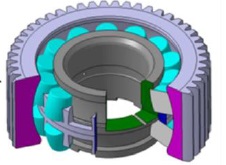


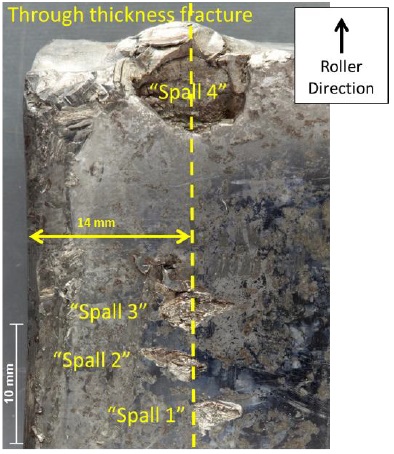

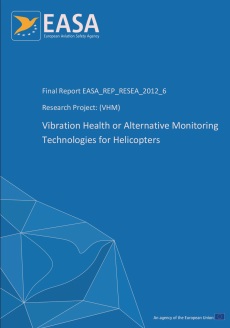

Recent Comments